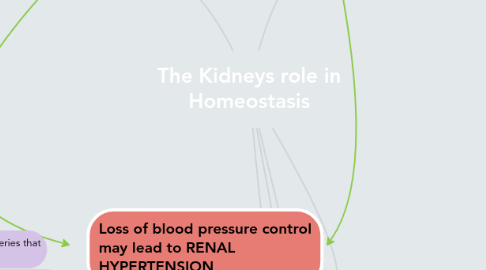
1. Regulates Blood Pressure
1.1. Kidney plays an important role in the long-term maintenance of arterial blood pressure.
1.2. When the extracellular fluid volume in the body rises, the arterial pressure also rises.
1.3. The Kidney interprets this rising pressure as a signal to excrete fluid, allowing the pressure to return toward normal.
2. Loss of blood pressure control may lead to RENAL HYPERTENSION
2.1. caused by a narrowing in the arteries that deliver blood to the kidney
2.1.1. When the kidneys receive low blood flow, they act as if the low flow is due to dehydration. So they respond by releasing hormones that stimulate the body to retain sodium and water. Blood vessels fill with additional fluid, and blood pressure goes up.
3. Nursing Diagnosis: Risk for Decreased Cardiac Output: At risk for inadequate blood pumped by the heart to meet metabolic demands of the body.
3.1. ASSESSMENT
3.1.1. Note skin color, temperature, and moisture.
3.1.1.1. Cold, clammy, and pale skin is secondary to compensatory increase in sympathetic nervous system stimulation and low cardiac output and oxygen desaturation.
3.1.2. Check for any alterations in level of consciousness.
3.1.2.1. Decreased cerebral perfusion and hypoxia are reflected in irritability, restlessness, and difficulty concentrating. Aged patients are particularly susceptible to reduced perfusion.
3.1.3. Assess heart rate and blood pressure.
3.1.3.1. Most patients have compensatory tachycardia and significantly low blood pressure in response to reduced cardiac output.
3.1.4. Check for peripheral pulses, including capillary refill.
3.1.4.1. Weak pulses are present in reduced stroke volume and cardiac output. Capillary refill is sometimes slow or absent.
3.1.5. Inspect fluid balance and weight gain. Weigh patient regularly prior to breakfast. Check for pedal and sacral edema.
3.1.5.1. Compromised regulatory mechanisms may result in fluid and sodium retention. Body weight is a more sensitive indicator of fluid or sodium retention than intake and output.
3.1.6. Record urine output. Determine how often the patient urinates.
3.1.6.1. The renal system counterbalances low BP by retaining water. Oliguria is a classic sign of decreased renal perfusion.
4. Desired Outcomes: Maintain cardiac output as evidenced by BP and heart rate within patient’s normal range; peripheral pulses strong and equal with prompt capillary refill time.
5. INTERVENTION
5.1. Closely monitor fluid intake including IV lines. Maintain fluid restriction if ordered.
5.1.1. In patients with decreased cardiac output, poorly functioning ventricles may not tolerate increased fluid volumes.
5.2. Auscultate heart sounds; note rate, rhythm, presence of S3, S4, and lung sounds.
5.2.1. The new onset of a gallop rhythm, tachycardia, and fine crackles in lung bases can indicate onset of heart failure. If patient develops pulmonary edema, there will be coarse crackles on inspiration and severe dyspnea.
5.3. If chest pain is present, have patient lie down, monitor cardiac rhythm, give oxygen, run a strip, medicate for pain, and notify the physician.
5.3.1. These actions can increase oxygen delivery to the coronary arteries and improve patient prognosis.
5.4. Auscultate heart sounds
5.4.1. The new onset of a gallop rhythm, tachycardia, and fine crackles in lung bases can indicate onset of heart failure. If patient develops pulmonary edema, there will be coarse crackles on inspiration and severe dyspnea.
5.5. Closely monitor for symptoms of heart failure and decreased cardiac output, including diminished quality of peripheral pulses, cold and clammy skin and extremities, increased respiratory rate, presence of paroxysmal nocturnal dyspnea or orthopnea, increased heart rate, neck vein distention, decreased level of consciousness, and presence of edema.
5.5.1. As these symptoms of heart failure progress, cardiac output declines.
5.6. Monitor blood pressure, pulse, and condition before administering cardiac medications such as angiotensin converting enzyme (ACE) inhibitors, digoxin, and beta-blockers such as carvedilol. Notify physician if heart rate or blood pressure is low before holding medications.
5.6.1. It is necessary for the nurse to assess how well the patient is tolerating current medications before administering cardiac medications; do not hold medications without physician input. The physician may decide to have medications administered even though the blood pressure or pulse rate has lowered.
